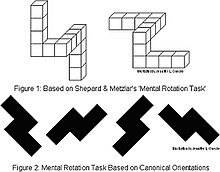User:Earth's gate/sandbox
| Part of a series on |
| Sex differences in humans |
|---|
| Biology |
| Medicine and health |
|
| Neuroscience and psychology |
|
| Sociology |
Differences in
Some research indicates that male advantages on some
Historical perspectives
Prior to the 20th century, it was a commonly held view that men were intellectually superior to women.[7][8] In 1801, Thomas Gisborne said that women were naturally suited to domestic work and not spheres suited to men such as politics, science, or business. He stated that this was because women did not possess the same level of rational thinking that men did and had naturally superior abilities in skills related to family support.
In 1875, Herbert Spencer said that women were incapable of abstract thought and could not understand issues of justice and had only the ability to understand issues of care.[9] In 1925, Sigmund Freud also stated that women were less morally developed in the concept of justice and, unlike men, were more influenced by feeling than rational thought.[9] Early brain studies comparing mass and volumes between the sexes concluded that women were intellectually inferior because they have smaller and lighter brains.[10] Many believed that the size difference caused women to be excitable, emotional, sensitive, and therefore not suited for political participation.[11]
In the nineteenth century, whether men and women had equal intelligence was seen by many as a prerequisite for the granting of
During the early twentieth century, the scientific consensus shifted to the view that gender plays no role in intelligence.[12]
In his 1916 study of children's IQs, psychologist Lewis Terman concluded that "the intelligence of girls, at least up to 14 years, does not differ materially from that of boys". He did, however, find "rather marked" differences on a minority of tests. For example, he found boys were "decidedly better" in arithmetical reasoning, while girls were "superior" at answering comprehension questions. He also proposed that discrimination, lack of opportunity, women's responsibilities in motherhood, or emotional factors may have accounted for the fact that few women had careers in intellectual fields.[13][14]
Research on general intelligence
Background
Chamorro-Premuzic et al. stated, "The g factor, which is often used synonymously with general intelligence, is a latent variable which emerges in a factor analysis of various cognitive ('IQ') tests. They are not exactly the same thing. g is an indicator or measure of general intelligence; it's not general intelligence itself."[15]
All or most of the major tests commonly used to measure intelligence have been constructed so that there are no overall score differences between males and females. Thus, there is little difference between the average IQ scores of men and women.[16][17] Differences have been reported, however, in specific areas such as mathematics and verbal measures.[4][6][5] Also, studies have found the variability of male scores is greater than that of female scores, resulting in more males than females in the top and bottom of the IQ distribution.[6]
In favor of males or females in g factor
Research, using the Wechsler Adult Intelligence Scale (WAIS III and WAIS-R), that finds general intelligence in favor of males indicates a very small difference.[3] This is consistent across countries.[3] In the United States and Canada, the IQ points range from two to three points in favor of males, while the points rise to four points in favor of males in China and Japan.[3] By contrast, some research finds greater advantage for adult females.[4] For children in the United States and the Netherlands, there are one to two IQ point differences in favor of boys.[3] Other research has found a slight advantage for girls on the residual verbal factor.[3]
A 2004 meta-analysis by Richard Lynn and Paul Irwing published in 2005 found that the mean IQ of men exceeded that of women by up to 5 points on the Raven's Progressive Matrices test.[18][19] Lynn's findings were debated in a series of articles for Nature.[20] He argued that there is a greater male advantage than most tests indicate, stating that because girls mature faster than boys, and that cognitive competence increases with physiological age, rather than with calendar age, the male-female difference is small or negative prior to puberty, but males have an advantage after adolescence and this advantage continues into adulthood.[3]
In favor of no sex differences or inconclusive consensus
Most studies find either a very small difference in favor of males or no sex difference with regard to general intelligence.[3][21] In 2000, researchers Roberto Colom and Francisco J. Abad conducted a large study of 10,475 adults on five IQ tests taken from the Primary Mental Abilities and found negligible or no significant sex differences. The tests conducted were on vocabulary, spatial rotation, verbal fluency and inductive reasoning.[21]
The literature on sex differences in intelligence has produced inconsistent results due to the type of testing used, and this has resulted in debate among researchers.[15] Garcia (2002) argues that there might be a small insignificant sex difference in intelligence in general (IQ) but this may not necessarily reflect a sex difference in general intelligence or g factor.[15] Although most researchers distinguish between g and IQ, those that argued for greater male intelligence asserted that IQ and g are synonymous (Lynn & Irwing 2004) and so the real division comes from defining IQ in relation to g factor. In 2008 Lynn and Irwing proposed that since working memory ability correlates highest with g factor, researchers would have no choice but to accept greater male intelligence if differences on working memory tasks are found. As a result, a neuroimaging study published by Schmidt (2009) conducted an investigation into this proposal by measuring sex differences on an n-back working memory task. The results found no sex difference in working memory capacity, thus contradicting the position put forward by Lynn and Irwing (2008) and more in line with those arguing for no sex differences in intelligence.[15]
A 2012 review by researchers
Although most of the tests showed no difference, there were some that did. For example, they found female subjects performed better on verbal abilities while males performed better on visuospatial abilities.[22] For verbal fluency, females have been specifically found to perform slightly better in vocabulary and reading comprehension and significantly higher in speech production and essay writing.[23] Males have been specifically found to perform better on spatial visualization, spatial perception, and mental rotation.[23] Researchers had then recommended that general models such as fluid and crystallized intelligence be divided into verbal, perceptual and visuospatial domains of g; this is because, as this model is applied, females excel at verbal and perceptual tasks while males excel on visuospatial tasks, thus evening out the sex differences on IQ tests.[22]
Variability
Some studies have identified the degree of IQ variance as a difference between males and females. Males tend to show greater variability on many traits; for example having both highest and lowest scores on tests of cognitive abilities.[6][5]
Feingold (1992b) and Hedges and Nowell (1995) have reported that, despite average sex differences being small and relatively stable over time, test score variances of males were generally larger than those of females."[24] Feingold "found that males were more variable than females on tests of quantitative reasoning, spatial visualisation, spelling, and general knowledge. ... Hedges and Nowell go one step further and demonstrate that, with the exception of performance on tests of reading comprehension, perceptual speed, and associative memory, more males than females were observed among high-scoring individuals."[24]
Brain and intelligence
Differences in brain physiology between sexes do not necessarily relate to differences in intellect. Although men have larger brains, men and women typically achieve similar IQ results.[25] For men, the gray matter volume in the frontal and parietal lobes correlates with IQ; for women, the gray matter volume in the frontal lobe and Broca's area (which is used in language processing) correlates with IQ.[26]
Women have greater cortical thickness, cortical complexity and cortical surface area (controlling for body size) which compensates for smaller brain size.[27] Meta-analysis and studies have found that brain size explains 6–12% of variance among individual intelligence and cortical thickness explains 5%.[28]
Mathematics performance

A performance difference in
In nearly every study on the subject, males have out-performed females on mathematics in high school, but the size of the male-female difference, across countries, is related to gender inequality in social roles.[32] In a 2008 study paid for by the National Science Foundation in the United States, however, researchers stated that "girls perform as well as boys on standardized math tests. Although 20 years ago, high school boys performed better than girls in math, the researchers found that is no longer the case. The reason, they said, is simple: Girls used to take fewer advanced math courses than boys, but now they are taking just as many."[33][34] However, the study indicated that, while boys and girls performed similarly on average, boys were over-represented among the very best performers as well as among the very worst.[35]
A 2011 meta-analysis with 242 studies from 1990 to 2007 involving 1,286,350 people found no overall sex difference of performance in mathematics. The meta-analysis also found that although there were no overall differences, a small sex difference that favored males in complex problem solving is still present in high school.[36]
With regard to gender inequality, some psychologists believe that many historical and current sex differences in mathematics performance may be related to boys' higher likelihood of receiving math encouragement than girls. Parents were, and sometimes still are, more likely to consider a son's mathematical achievement as being a natural skill while a daughter's mathematical achievement is more likely to be seen as something she studied hard for.[37] This difference in attitude may contribute to girls and women being discouraged from further involvement in mathematics-related subjects and careers.[37]
Stereotype threat has been shown to affect performance and confidence in mathematics of both males and females.[10][30]
Spatial ability


Metastudies show a male advantage in mental rotation and assessing horizontality and verticality[38] and a female advantage in spatial memory.[39][40] A proposed hypothesis is that men and women evolved different mental abilities to adapt to their different roles in society.[41] This explanation suggests that men may have evolved greater spatial abilities as a result of certain behaviors, such as navigating during a hunt.[42]
A number of studies have shown that women tend to rely more on visual information than men in a number of spatial tasks related to perceived orientation.[43]
Results from studies conducted in the physical environment are not conclusive about sex differences, with various studies on the same task showing no differences. For example, there are studies that show no difference in finding one's way between two places.[44]
Performance in mental rotation and similar spatial tasks is affected by gender expectations.
The possibility of
Sex differences in academics
A 2014 meta-analysis of sex differences in scholastic achievement published in the journal of Psychological Bulletin found females outperformed males in teacher-assigned school marks throughout elementary, junior/middle, high school and at both undergraduate and graduate university level.[50] The meta-analysis, done by researchers Daniel Voyer and Susan D. Voyer from the University of New Brunswick, drew from 97 years of 502 effect sizes and 369 samples stemming from the year 1914 to 2011.[50]
Beyond sex differences in academic ability, recent research has also been focusing on women's underrepresentation in higher education, especially in the fields of natural science, technology, engineering and mathematics (STEM).[51]
See also
- Empathy
- Sex differences in emotional intelligence
- Sex differences in humans
- Emotional intelligence
- Sex differences in psychology
- Heritability of IQ
References
- ^ ISBN 978-1133939535.
- ^ ISBN 978-1139495110.
- ^ ISBN 978-1139495110.
- ^ ISBN 978-0199585595.
- ^ ISBN 978-1317350873.
- ^ ISBN 978-1441914651.
- ISBN 978-1559346306.
- ISBN 978-0275991623.
- ^ ISBN 0122272455.
- ^ ISBN 1848313969.
- ^ ISBN 978-1-57181-045-8
- ^ Burt, C. L.; Moore, R. C. (1912). "The mental differences between the sexes". Journal of Experimental Pedagogy. 1 (273–284): 355–388.
- OCLC 186102.
- ^ Dennis W (1972). Historical readings in developmental psychology. Appleton-Century-Crofts. p. 214.
- ^ )
- ISBN 0122272455.
- ISBN 978-0826487155.
- PMID 16248939.
- .
- ^ Child D (2006). The Psychologist. British Psychological Society. p. 10.
- ^ ISBN 9780080437934.
- ^ PMID 22233090.
- ^ a b (us), National Academy of Sciences; (us), National Academy of Engineering; Engineering, and Institute of Medicine (US) Committee on Maximizing the Potential of Women in Academic Science and (2006-01-01). "Women in Science and Mathematics". National Academies Press (US).
{{cite journal}}: Cite journal requires|journal=(help) - ^ ISBN 9780521635332.
- ISBN 978-1111831004.
- ISBN 978-1506349190.
- ISBN 9780444536310.
- PMID 26449760.
- ^ "Gender differences in mathematics performance", p.196. OECD 2015.
- ^ ]
- PMID 6648516.
- ISBN 978-1111831004.
- ^ Lewin, Tamar (July 25, 2008)."Math Scores Show No Gap for Girls, Study Finds", The New York Times.
- ISBN 978-1305887428.
- ^ Winstein, Keith J. (July 25, 2008). "Boys' Math Scores Hit Highs and Lows", The Wall Street Journal (New York).
- PMID 21038941.
- ^ ISBN 0-205-36137-4
- ISBN 9781441914644.
- ]
- ]
- ^ Eals, Marion, and Irwin Silverman. 1992. Sex differences in spatial abilities: evolutionary theory and data. In The Adapted Mind: Evolutionary Psychology and the Generation of Culture, edited by J. H. Barkow. New York: Oxford University Press.[page needed]
- ISBN 978-1-55798-527-9.[page needed]
- ^ Witkin, H. A., Lewis, H. B., Hertzman, M., Machover, K., Meissner, P. B. & Wapner, S. (1954) Personality Through Perception. An Experimental and Clinical Study. Harper, New York.
- ^ ]
- ]
- ^ Newcombe, N. S. (2007). Taking Science Seriously: Straight thinking about spatial sex differences. In S. Ceci & W. Williams (eds.), Why aren't more women in science? Top researchers debate the evidence (pp. 69–77). Washington, DC: American Psychological Association.
- ISBN 978-0826157379.
- ISBN 978-0203089798.
- PMID 6396713.
- ^ PMID 24773502.
- ^ S. J. Ceci, W. M. Williams, Why Aren’t More Women in Science? (APA Books, Washington, DC, 2007)

